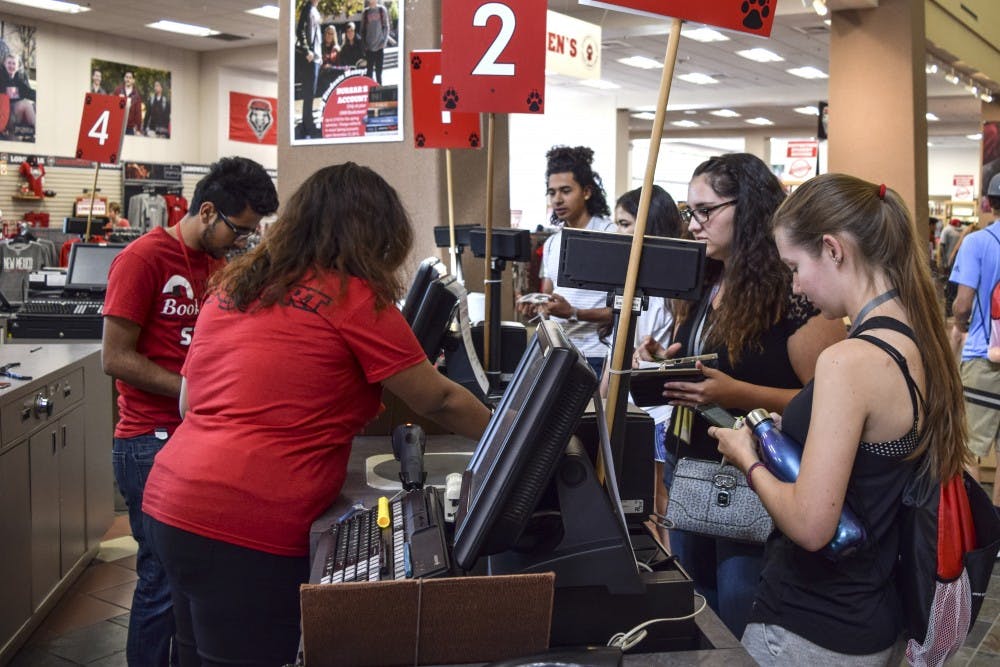With the growing movement for a nationwide raise hour minimum wage, now included in the National Democratic Party’s draft platform, it’s possible some student employees may see a difference in pay, but it would require uniform regulation reform across all departments.
Emily Arzate, a human resources representative for the Biology Department, said understanding how student employees are paid is complex. Student employees at UNM have a wide variety of responsibilities, and are paid by a wide variety of different funding sources.
Money is allocated to students through an intricate system of private grants, state funds and federal grants, she said. At UNM, there are a few basic types of student employees and 50 percent of the funding for federally funded work-study employees comes from the federal government.
For state-funded work study employees, 30 percent of the wage is paid for by the state, Arzate said, while funding for a non-work study employee wage can come from any of a variety of private and government grants, as well as from state-funded line items in the UNM budget.
Isaiah Archuleta, a student employment HR technician at UNM, said although work study student salaries are partially paid for by the state or federal government, work study students do not necessarily have higher wages than non work study students.
Work-study employees, both federally and state funded, and non work-study employees paid by third party grants have a minimum wage of $8.50/hr, he said. Exact pay is determined by the UNM pay scale.
Archuleta said the scale ranges from entry level positions with a base pay of $8.50/hr to Technical Specialist with a base pay of $9.50/hr. All student positions have a cap of $17/hr.
However, student employees who are funded by federal grants, including work study students where the non-work study portion of pay comes from a federal grant, have a minimum wage of $10/hour, with the same $17/hr wage cap, he said.
Arzate said it could be beneficial to fix the discrepancies in pay between student employees funded by federal grants and students paid from non-federal funds.
This would require either lowering the $10 minimum wage of federal grant employees or raising the minimum wage of employees paid from non-federal sources, she said.
A student’s pay is determined by the amount of responsibility, skill and duties the job requires, Arzate said. When a listing is first created, the faculty member applies to the Student Employment Department with the desired pay scale in mind.
According to the UNM Student Employment Handbook, domestic students are allowed to work a maximum of 30 hours a week and UNM international Student Employees are allowed to work up to 20 hours per week.
Get content from The Daily Lobo delivered to your inbox
However, according to the handbook, it gets more complicated. The amount of hours allowed varies depending on department budgets, as departments can permit student employees to work 40 hours a week if an override is approved through Student Employment.
The hours a student can work are also often limited by the funds available.
Amanda Johnson, a senior English major at UNM explained that, as a student employee, her job within the ASUNM Arts and Craft Studio department budget only allows her to work 20 hours a week.
Because Johnson is only allotted 20 hours of work a week in that position, she said she has had to take on a second job.
“If I wanted to live off of my student job I would need to work more than 20 hours a week and probably make more than what I make now,” Johnson said. “If I received $15 an hour, that would be amazing and I would not have to work two jobs. I would be able to do all the things that I need to do, including paying my tuition, because that is where the majority of my money goes.
Johnson, like many other UNM students, acknowledged that if UNM had better compensation and pay she would be able to quit her second job.
Archuleta and Arzate explained that to obtain a raise of more than 50 cents, a student employee must take on new responsibilities and develop new skills. In other words, a raise of 50 cents or less can be approved easily, but a raise of a dollar or more requires student employees to take on higher-level duties with more responsibilities.
Johnson said she received a small raise of under 50 cents within her first year in the ASUNM Arts and Craft Studio, but that was not sufficient to have a significant impact.
Lewis Serrano, a senior language and linguistics major at UNM, said he too was only allowed to work 20 hours a week but, unlike Johnson, he was a work study employee.
Despite that, Serrano said in the end he was not able to make a livable wage at his job at UNM.
When asked about the $15/hr minimum wage movement, Serrano said he wasn’t sure about such a large increase in pay.
“It would depend on where the money is coming from. If it means an increase in student fees, then definitely not. I think $10 is more manageable and realistic,” he said. “I feel the University has to acknowledge the necessity of paying students wages that will support them while working on their higher education.”
Serrano said, from his own personal experience, many student employees live off their student wages, which can be a struggle when they are paid minimum wage and limited to 20 hours a week.
Serrano said his wages paid for his food and rent.
“Normally it would just be enough for that. Most weeks I would struggle to get by,” he said.
Achieving a $15 minimum wage or even a $10 minimum wage at UNM would require new regulations across all departments. Departments with significantly smaller budgets and/or less funding from outside grants would struggle with paying employees higher wages.
Archuleta said, at the moment, work study employees are not compensated on average more or less than non-work study employees, and when a student receives work study funding, it is acknowledged (through their FAFSA) that the student needs financial help.
Work-study allows for departments to offer more jobs to more students, because departments receive financial help from either the state or federal work study programs, he said. But the work study programs do not result in increased hourly pay relative to non-work study positions.
Arzate said she could get behind an increased minimum wage of $10-15/hr if staff positions were included in the conversation, adding that many UNM staff positions do not pay $15/hr.
For more information regarding UNM student jobs, please see the UNM Jobs website. For More information regarding student employee regulation can be found in the Student Employment Handbook, or by e-mailing stuemp@unm.edu.






